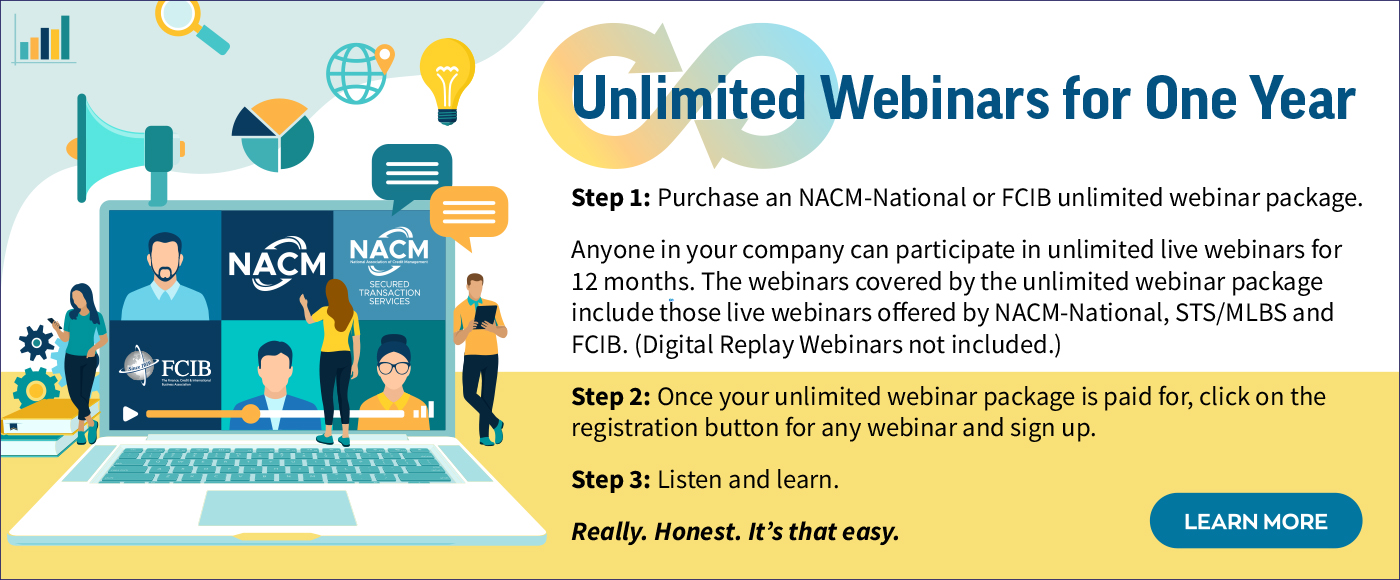eNews June 3
|
In the News
June 3, 2021
Credit ‘Cheat Sheet’
Could Make Everyone’s Business Life Easier
Annacaroline Caruso, editorial associate
The credit department is an integral part of a company as staff interacts with internal departments throughout the order-to-cash cycle. Have you ever tried explaining how credit management works to someone outside of your department? That sometimes can be a daunting task
Clear communication between departments, however, is key to keep a company running like a well-oiled machine. Without it, the whole process can start to fall apart. That’s one reason why Brooke Wilson, ICCE, region credit controller with Volvo Penta of the Americas (Chesapeake, VA), created a credit cheat sheet, “a sort of credit 101, if you will,” for non-financial staff.
“It’s this handy tool that if we’re speaking to [sales staff], they know what we’re talking about,” Wilson explained. “This way we’re working as a team and we are able to communicate effectively to speak with the customer and be in alignment across the board.”
It is a three-page Excel document consisting of a balance sheet, income statement and definitions of common terms or metrics. For the most part, it includes whatever you’re evaluating and assessing as a company with your sales team, Wilson said.
The goal is to reduce friction between the credit and sales departments and to help the company run more seamlessly. According to NACM’s Principles of Business Credit, the three Cs in a successful credit and sales relationship are “communication, collaboration and cooperation,” all of which this document aims to improve.
When financial information is not properly shared between the sales and credit departments, it can make both jobs more difficult, she added. Communicating concerns to the sales team is often helpful in getting the information you need about a customer’s financial situation. In turn, the sales team notifies the credit department of changes in communications or payment or order patterns.
“People think ‘oh sales, they aren’t numbers people,’ but they have KPIs to meet, they have metrics to meet, so it’s just introducing it in a different way,” Wilson said.
This document strips complicated credit lingo and practices down to the basics so the information can be easily understood by all parties.
“We found that a lot of our commercial sales guys out in the field would ask for financials,” she said. “If we weren’t a part of the conversation with the customer and explaining things, they didn’t understand how to have those conversations with customers, like why they were denied or why they were approved under certain terms.”
Educating others “in the organization is critical to success because it really gets everyone on the same page and gets everyone functioning as a true team,” Wilson explained. It can be easily created and tailored to fit a company’s specific needs and metrics.
It has been worth the time it took to create it, she added. “You definitely see a return on investment. You’re not fielding as many calls or questions, and it minimizes that extra back-and-forth that you would normally have.”
Wilson shared this idea during one of the NACM thought leader group meetings on metrics. Have something helpful to share? Working on an innovative project in your credit department? Or want to hear what other credit professionals are up to? Contact Education Director Tracey Lerminiaux at This email address is being protected from spambots. You need JavaScript enabled to view it. to learn more about these groups.
Surety Bonds Showing Up More
on Private Construction Projects
Bryan Mason, editorial associate
Surety bonds historically have been used on public and federal projects as a way for project owners to ensure general contractors finish projects and all parties get paid—keeping the projects free of liens. However, more owners are now requiring general contractors to use these bonds on private projects as well.
“State laws do not require surety bonds on private jobs unless owners or general contractors require them within their contracts,” said Connie Baker, CBA, director of operations for NACM Secured Transaction Services (STS).
Baker recommends that credit managers ask whether a surety bond has been required on a private project. “If you confirm that there is a bond on a private job, get a copy,” she stressed.
“The only way to know whether you are a claimant and what you need to do to file a claim is to read the bond,” she said. “You must read them.”
NACM STS’s Chris Ring agreed. “If you are a material supplier, read the bond to confirm whether you’re covered. Some private bonds have been known to only provide payment protection for subcontractors.”
State statutes do not govern payment bonds on private jobs, but most private bonds will incorporate private construction statutes into the bond. The bond, however, will not explicitly state the law or requirements such as if a notice or bond claim is required.
“So, make sure you also read the state law,” Baker said. For example, some states require the filing of preliminary notices in order to file claims against a project. Requirements and deadlines for sending preliminary notices and filing claims vary by state, so complying with state statute is vital for having an effective claim.
After you establish your claim, the surety will contact you to request a statement paired with supporting documents. Sending these items quickly is critical to keep the process moving swiftly. The surety company will then pressure the general contractor to pay you.
“A surety bond can be used as an extra collection tool,” she said. “If you file a surety bond claim, the surety will contact the general contractor to find out why it hasn’t paid.”
In cases where the surety company pays a subcontractor or supplier, the surety will go back to the general contractor for reimbursement.
Filing a payment bond claim “can also be cheaper than filing a foreclosure action on the property,” Baker said. “Some states do not even allow you to file a lien if a payment bond has been taken out. For example, in the state of Florida, when an unconditional payment bond is properly recorded, a lien cannot be filed against the property.” In most other states, you have the right to file both a lien and bond claim, she added.
“A payment bond posted on a private project does not necessarily eliminate your ability to file a lien on the property,” Ring added. “So don’t dismiss maintaining your lien rights just because there is a payment bond.”
The most commonly used surety bonds include payment and performance bonds. A payment bond ensures subcontractors and suppliers get paid by the general contractor, while performance bonds ensure a project will be completed to the owner’s satisfaction.
Keep pressure on both the surety and the general contractor to guarantee your claim is resolved. In situations where there are extended delays or your claim is denied, filing suit against the surety may be warranted.
Subscribers to the Lien Navigator, accessed through the NACM STS website, can learn more about individual state statutes regarding payment bonds on public and federal construction jobs.
Listening Is Hard Work
Lisa Aldisert, Ph.D.
There’s no way around this: You need to work harder at listening when you’re not face to face. Generally, your people will tell you everything is fine … even when it isn’t.
For example, you may check in about progress toward a particular deadline and people will say that they’re on top of it. Maybe they are. But maybe not.
Asking about progress may be fine for some people, but for others you may need to be much more specific. Based on the person’s response, you can continue to ask questions until you receive satisfactory answers.
A good listener needs to listen between the lines. That is, pay attention so carefully that you’ll ask the right questions in order to get accurate answers. The quality of your questions makes a big difference.
We speak at a pace of around about 125-150 words a minute, but our capacity for listening is a whopping 400-800 words per minute. That is the basis for why it’s hard for people to be good listeners: Other things fill the space when you’re listening but not fully paying attention.
With this in mind:
- Eliminate all distractions when you are listening. Don’t look at your phone, check email or read through a document. Focus on the person who is speaking!
- Video technology can help, but I’ve been on plenty of video calls where participants are still answering email while participating.
- Seek clarification. If people aren’t clear in their delivery, ask them to say it differently. Alternatively, you can paraphrase what you think they said to confirm that you heard correctly.
- If you are delivering the message, ask the other person to repeat back what you said to ensure that what you said was understood.
- Use your gut. If the other person’s tone of voice or pace is different from usual, this may alert you that something may be off.
Listening is hard work. It takes discipline and focus to get good at it, and mastery can take years. For now, though, if you are managing a remote team, it's well worth putting in the extra effort.
Join Lisa Aldisert, Ph.D., at the next NACM and FCIB Author Chat, 11 a.m., June 17, as she discusses her book Leadership Reflections: 52 Leadership Practices in the Age of Worry. Read the book and join in the discussion.
Despite a broad consensus across large and midsize organizations about the rising threat posed by a range of emerging risks, the vast majority continue to overlook and underemphasize the potential impact of these risks on their businesses, according to the inaugural Marsh Risk Resilience Report.
“Responses suggest that organizations are placing too much emphasis on certain perils—primarily those that pose an imminent threat—while other risks that are perceived as slower to evolve, but have similarly pervasive impacts, are largely overlooked,” the report finds.
Based on a global survey of nearly 1,000 organizations, the report highlights large disparities in the perception of and response to threats posed by the following six issues:
- Pandemic
- Cyberattack
- Emerging technologies
- Environmental, social and governance
- Regulatory changes
- Geopolitical risks
While 75% of respondents to the survey believe that their risk management processes are aligned to their long-term growth strategies, only a quarter of respondents stated they have a comprehensive or formal process in place to evaluate and model the impact of these emerging risks on their business.
“Despite broad consensus on the rising importance—and potential threat—posed by the six risks, only 25% of companies are evaluating or modeling the impact of emerging risks on their business,” the report states.
The findings suggest a significant perception gap with firms’ risk management functions prioritizing short-term threats over those that are high severity but lower frequency, according to Marsh. This potentially leaves them vulnerable to immediate and long-term disruptions to their operations, assets, and revenue streams, the report concludes.
According to Marsh, resilience involves four common steps and behaviors:
- Anticipating important risk issues;
- Connecting risk management to business strategy;
- Avoiding gaps in the perception of preparedness; and
- Measuring relevant data.
Marsh’s Risk Resilience Report is based on a survey of around 1,000 Marsh clients conducted in early 2021 across nine regions. Respondents represented more than 36 industries, including manufacturing, energy, real estate, retail, construction, health care, banking and financial services, and professional services. The survey's objective was to measure respondents' resilience in six emerging risk areas—climate/ESG, cyber/technology, emerging technologies, geopolitical, pandemic and regulatory.
|
Upcoming Webinars |
|
June 15 |
Blockchain Technology & Decentralized Finance
Speakers: Anjon Roy and David Wasson, SIMBA Chain |
| NACM and FCIB Present Author Chat: Leadership Reflections: 52 Leadership Practices in the Age of Worry Author: Dr. Lisa M. Aldisert |
June 17 |
|
June 17 |
Regulatory Compliance 101: What is regulatory compliance and why is it important? Speaker: Chris Doxey, CAPP, CCSA, CICA, CPC, Doxey Inc. |









